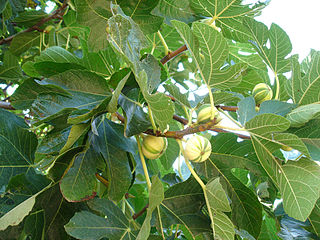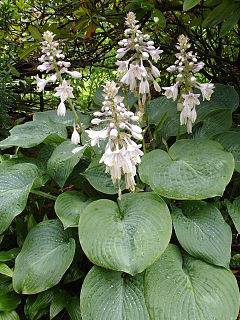
Firs (Abies) are a genus of 48–56 species of evergreen coniferous trees in the family Pinaceae. They are found through much of North and Central America, Europe, Asia, and North Africa, occurring in mountains over most of the range. Firs are most closely related to the genus Cedrus (cedar). Douglas firs are not true firs, being of the genus Pseudotsuga.

Variegation is the appearance of differently coloured zones in the leaves and sometimes the stems, of plants. Variegated leaves occur rarely in nature. Species with variegated individuals are sometimes found in the understory of tropical rainforests, and this habitat is the source of a number of variegated house plants.
Hidden Lake Gardens colloquially known as Hidden Lake 755 acres (3.06 km2), is a botanical garden and an arboretum operated by Michigan State University situated in the Irish Hills of southeast Michigan. The Gardens are known for their large collection of native and nonnative trees, shrubs and flowers. HLG was given to Michigan State University by Harry Fee in 1945. Today it is visited by nearly 45,000 people annually. Hidden Lake Gardens mission is to "preserve and enhance the natural beauty of the gardens and to display plants for the inspiration and education of the public".

The Christchurch Botanic Gardens, located in the central city of Christchurch, New Zealand, were founded in 1863 when an English oak was planted to commemorate the solemnisation of the marriage of Prince Albert and Princess Alexandra of Denmark.

Hosta is a genus of plants commonly known as hostas, plantain lilies and occasionally by the Japanese name giboshi. Hostas are widely cultivated as shade-tolerant foliage plants. The genus is currently placed in the family Asparagaceae, subfamily Agavoideae, and is native to northeast Asia. Like many "lilioid monocots", the genus was once classified in the Liliaceae. The genus was named by Austrian botanist Leopold Trattinnick in 1812, in honor of the Austrian botanist Nicholas Thomas Host. In 1817, the generic name Funkia was used by German botanist Kurt Sprengel in honor of Heinrich Funk, a collector of ferns and alpines; this was later used as a common name and can be found in some older literature.

Hosta 'Undulata' is a cultivar of the genus Hosta, widely cultivated as ornamental plants in borders or as specimen plants. It was formerly regarded as a species under the name Hosta undulata(Otto & A.Dietr.) L.H.Bailey. It is not accepted as a species by the World Checklist of Selected Plant Families as of August 2011, and has been relegated to cultivar status by Schmid.
A Group is a formal category in the International Code of Nomenclature for Cultivated Plants (ICNCP) used for cultivated plants (cultivars) that share a defined characteristic. It is represented in a botanical name by the symbol Group or Gp. "Group" or "Gp" is always written with a capital G in a botanical name, or epithet. The Group is not italicized in a plant's name. The ICNCP introduced the term and symbol "Group" in 2004, as a replacement for the lengthy and hyphenated "cultivar-group", which had previously been the category's name since 1969. For the old name "cultivar-group", the non-standard abbreviation cv. group or cv. Group is also sometimes encountered. There is a slight difference in meaning, since a cultivar-group was defined to comprise cultivars, whereas a Group may include individual plants.

Lavandula angustifolia, formerly L. officinalis, is a flowering plant in the family Lamiaceae, native to the Mediterranean.

Chadwick Arboretum is a 62 acres (25 ha) arboretum on the Agriculture campus of The Ohio State University, in Columbus, Ohio, United States. The main arboretum collection is located just across Lane Avenue from the Schottenstein Center with its other collections nearby. The arboretum is open daily without charge.

Greensboro Arboretum is an arboretum located in Lindley Park at 401 Ashland Drive, Greensboro, North Carolina. It is open to the public daily without charge.

Arum italicum is a species of flowering herbaceous perennial plant in the family Araceae, also known as Italian arum and Italian lords-and-ladies. It is native to the Mediterranean region. It is also naturalized in Great Britain, the Netherlands, Crimea, Caucasus, Canary Islands, Madeira, Azores, Argentina and in scattered locations in the United States.

Nepenthes alba is a tropical pitcher plant endemic to Peninsular Malaysia. The specific epithet alba is derived from the Latin word albus, meaning "white", and refers to the colour of the upper pitchers.
Franz Wilhelm Sieber, was a botanist and collector who travelled to Europe, the Middle East, Southern Africa and Australia.

Lippia alba is a species of flowering plant in the verbena family, Verbenaceae, that is native to southern Texas in the United States, Mexico, the Caribbean, Central America, and South America. The species is also present in Australia and India, where it is probably a human introduction. Common names include bushy matgrass, bushy lippia, hierba negra, and pitiona. It is a multi-branched shrub, reaching a height of 1.5 m (4.9 ft). Leaves measure 1 to 3 cm in length and 0.9 to 2 cm in width and are opposite or in threes. Flowers with white, pink, or light blue-purple corollas form on spikes 2 cm (0.79 in) long.
Tony Avent is an American horticulturist and plantsman. He and wife and business partner, Anita Avent, own Plant Delights Nursery and Juniper Level Botanic Garden in Raleigh, North Carolina. In addition, he is a well-known plant explorer, author and public speaker.

Drimiopsis maculata, also known by the common names little white soldiers, African false hosta, African hosta, leopard plant, is a flowering plant species in the genus Drimiopsis. It is the type species of its genus. It occurs from Tanzania to South Africa.

Hosta virus X (HVX) is a virus that infects Hostas. The disease was first identified in 1996 by plant pathologists at the University of Minnesota. The virus has reached epidemic proportions and can be found in most garden centers and nurseries around the globe.

Hosta sieboldiana, Siebold's plantain lily, is a species of hosta native to Japan. A putative variety, Hosta sieboldiana var. elegans, has gained the Royal Horticultural Society's Award of Garden Merit. The cultivars 'Blue Angel', 'Blue Mammoth', and 'Olive Bailey Langdon' have also gained the RHS Award of Garden Merit.














